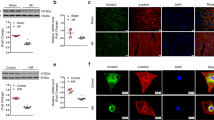Abstract
Molecular events involved in acute myocardial infarction (AMI) still remain unclear. A rat AMI model and cardiomyocytes cultured in vitro were used to mimic hypoxic conditions, and the profiles of histone methylation-related gene expression were explored. The demethylase Kdm6a expression was significantly upregulated in the rat AMI model and in hypoxia induction. The apoptosis rate of cardiomyocytes was significantly exacerbated when Kdm6a was knocked down. The expression of the Na+/Ca2+ exchanger (Ncx) was significantly upregulated in cardiomyocytes under hypoxia. Knockdown of Kdm6a downregulated the Ncx expression via enhancing H3K27me3 modification on Ncx gene promoter, and attenuated the intracellular calcium influx ability in cardiomyocytes as a consequence. Kdm6a regulates Ncx expression through reducing the H3K27me3 level on the Ncx promoter or enhancer. This finding provides a basis for further study of Kdm6a as a new regulator for AMI development.





Similar content being viewed by others
References
Gong, L. C., et al. (2017). Long non-coding RNA H19 protects H9c2 cells against hypoxia-induced injury by targeting microRNA-139. Cellular Physiology and Biochemistry : International Journal of Experimental Cellular Physiology, Biochemistry, and Pharmacology, 44, 857–869. https://doi.org/10.1159/000485354.
Nattel, S., & Harada, M. (2014). Atrial remodeling and atrial fibrillation: recent advances and translational perspectives. Journal of the American College of Cardiology, 63, 2335–2345. https://doi.org/10.1016/j.jacc.2014.02.555.
Dorn, G. W., 2nd. (2009). Apoptotic and non-apoptotic programmed cardiomyocyte death in ventricular remodelling. Cardiovascular Research, 81, 465–473. https://doi.org/10.1093/cvr/cvn243.
Aurora, A. B., et al. (2012). MicroRNA-214 protects the mouse heart from ischemic injury by controlling Ca(2)(+) overload and cell death. The Journal of Clinical Investigation, 122, 1222–1232. https://doi.org/10.1172/JCI59327.
Frey, N., McKinsey, T. A., & Olson, E. N. (2000). Decoding calcium signals involved in cardiac growth and function. Nature Medicine, 6, 1221–1227. https://doi.org/10.1038/81321.
Bers, D. M., Despa, S., & Bossuyt, J. (2006). Regulation of Ca2+ and Na+ in normal and failing cardiac myocytes. Annals of the New York Academy of Sciences, 1080, 165–177. https://doi.org/10.1196/annals.1380.015.
Papait, R., et al. (2017). Histone methyltransferase G9a is required for cardiomyocyte homeostasis and hypertrophy. Circulation, 136, 1233–1246. https://doi.org/10.1161/CIRCULATIONAHA.117.028561.
Dal-Pra, S., Hodgkinson, C. P., Mirotsou, M., Kirste, I., & Dzau, V. J. (2017). Demethylation of H3K27 is essential for the induction of direct cardiac reprogramming by miR combo. Circulation Research, 120, 1403–1413. https://doi.org/10.1161/CIRCRESAHA.116.308741.
Agger, K., et al. (2007). UTX and JMJD3 are histone H3K27 demethylases involved in HOX gene regulation and development. Nature, 449, 731–734. https://doi.org/10.1038/nature06145.
Lee, M. G., et al. (2007). Demethylation of H3K27 regulates polycomb recruitment and H2A ubiquitination. Science, 318, 447–450. https://doi.org/10.1126/science.1149042.
Lee, S., Lee, J. W., & Lee, S. K. (2012). UTX, a histone H3-lysine 27 demethylase, acts as a critical switch to activate the cardiac developmental program. Developmental Cell, 22, 25–37. https://doi.org/10.1016/j.devcel.2011.11.009.
Song, J. Q., Teng, X., Cai, Y., Tang, C. S., & Qi, Y. F. (2009). Activation of Akt/GSK-3beta signaling pathway is involved in intermedin(1-53) protection against myocardial apoptosis induced by ischemia/reperfusion. Apoptosis: an International Journal on Programmed Cell Death, 14, 1299–1307. https://doi.org/10.1007/s10495-009-0398-7.
Jia, Z., et al. (2016). SOX6 and PDCD4 enhance cardiomyocyte apoptosis through LPS-induced miR-499 inhibition. Apoptosis: an International Journal on Programmed Cell Death, 21, 174–183. https://doi.org/10.1007/s10495-015-1201-6.
Li, W., et al. (2018). MALAT1 promotes cell apoptosis and suppresses cell proliferation in testicular ischemia-reperfusion injury by sponging MiR-214 to modulate TRPV4 expression. Cellular Physiology and Biochemistry : International Journal of Experimental Cellular Physiology, Biochemistry, and Pharmacology, 46, 802–814. https://doi.org/10.1159/000488738.
Nazir, S., et al. (2017). Acute myocardial infarction and antiphospholipid antibody syndrome: a systematic review. Coronary Artery Disease, 28, 332–335. https://doi.org/10.1097/MCA.0000000000000476.
Gurard-Levin, Z. A., & Almouzni, G. (2014). Histone modifications and a choice of variant: a language that helps the genome express itself. F1000prime Reports, 6, 76. https://doi.org/10.12703/P6-76.
Milan, M., et al. (2018). Givinostat reduces adverse cardiac remodeling through regulating fibroblasts activation. Cell Death & Disease, 9, 108. https://doi.org/10.1038/s41419-017-0174-5.
Rosales, W., Carulla, J., Garcia, J., Vargas, D., & Lizcano, F. (2016). Role of histone demethylases in cardiomyocytes induced to hypertrophy. BioMed Research International, 2634976. https://doi.org/10.1155/2016/2634976.
Sventzouri, S., et al. (2017). Pharmacologic inhibition of the mitochondrial Na(+)/Ca(2+) exchanger protects against ventricular arrhythmias in a porcine model of ischemia-reperfusion. Hellenic Journal of Cardiology. https://doi.org/10.1016/j.hjc.2017.12.009.
Yang, K. C., Bonini, M. G., & Dudley, S. C., Jr. (2014). Mitochondria and arrhythmias. Free Radical Biology & Medicine, 71, 351–361. https://doi.org/10.1016/j.freeradbiomed.2014.03.033.
Funding
This study was supported by the National Natural Science Foundation of China (81700293).
Author information
Authors and Affiliations
Corresponding author
Ethics declarations
Conflict of Interest
The authors declare that they have no conflicts of interest.
Research Involving Human Participants
N/A.
Animal Research Ethical Approval
The use of animals was approved by the Ethics Committees of Beijing Anzhen Hospital Affiliated with the Capital Medical University of China and conformed to the Guide for the Care and Use of Laboratory Animals published by the US National Institutes of Health (Publication No. 85-23, revised 1996).
Additional information
Associate Editor Joost Sluijter oversaw the review of this article
Publisher’s Note
Springer Nature remains neutral with regard to jurisdictional claims in published maps and institutional affiliations.
Clinical Relevance
1. Increased Kdm6a level may lead to dysregulation of Ncx channel expression and attenuated the intracellular calcium influx ability in AMI progression.
2. Kdm6a might be a novel endogenous trigger of AMI and might be a potential target for the treatment of AMI in clinic.
Rights and permissions
About this article
Cite this article
Li, Y., Quan, X., Li, X. et al. Kdm6A Protects Against Hypoxia-Induced Cardiomyocyte Apoptosis via H3K27me3 Demethylation of Ncx Gene. J. of Cardiovasc. Trans. Res. 12, 488–495 (2019). https://doi.org/10.1007/s12265-019-09882-5
Received:
Accepted:
Published:
Issue Date:
DOI: https://doi.org/10.1007/s12265-019-09882-5




